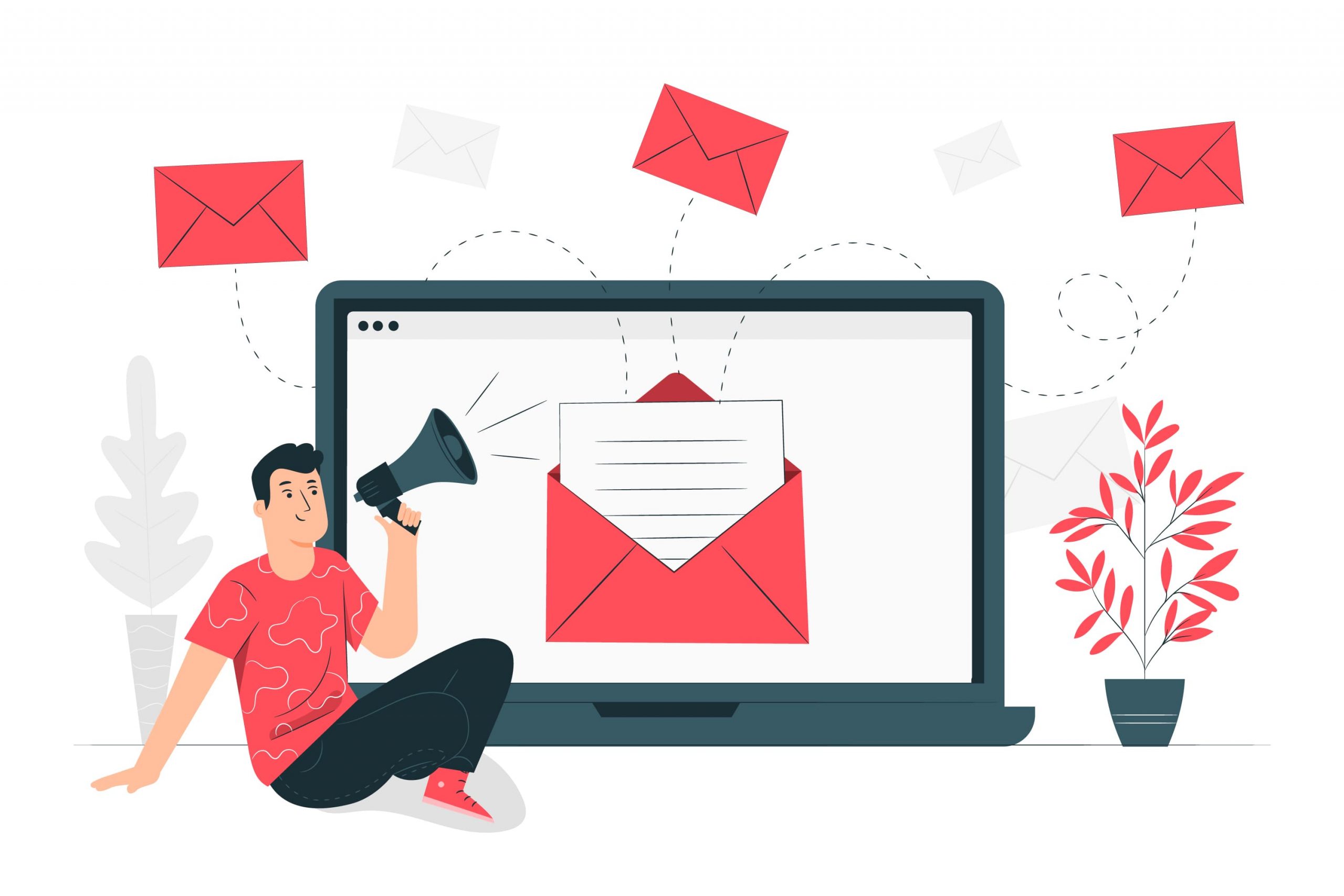Are you tired of traditional marketing methods that seem to fall flat? Looking for a way to connect with your audience more personally? Look no further than email marketing! In today’s digital age, email has become essential for businesses to reach and engage their customers. But what exactly is email marketing, and how can you do it right?
In this blog post, we will dive into the basics of email marketing and explore strategies for creating effective campaigns. We’ll also discuss the importance of choosing the right email service provider and share some best practices to ensure your emails hit all the right notes. So grab your favourite beverage, sit back, and get ready to master the art of email marketing!
The Basics of Email Marketing
Email marketing is a powerful tool that allows businesses to connect with their audience directly and personally. But before diving into the strategies and best practices, it’s essential to understand the basics of email marketing.
Building an email list is key. This involves collecting email addresses from your website visitors, customers, or leads. Obtaining permission to email these individuals through opt-in forms or checkboxes is essential.
Once you have a solid subscriber base, you can send marketing emails. These can be newsletters, product updates, promotions, or even personalized messages based on customer behaviour. The goal is to provide valuable content and incentives that keep subscribers interested in your offer.
To ensure your emails reach their intended recipient’s inbox instead of ending up in spam folders, it’s crucial to follow email deliverability best practices. This includes using a reputable email service provider (ESP), optimizing subject lines and sender names for better open rates, and avoiding spam trigger words or excessive capitalization in your content.
Remember that consistency is key when it comes to email marketing success. Regularly monitor your campaigns’ performance by analyzing open rates, click-through rates (CTR), conversion rates, and unsubscribe rates. Use this data-driven insight from analytics tools provided by ESPs like Mailchimp or Constant Contact –to continuously improve and optimize future campaigns for maximum impact!
Setting Up Email Marketing Campaigns
Setting up email marketing campaigns can be an exciting and rewarding process. It allows businesses to reach out directly to their target audience, build brand awareness, and drive conversions. But where do you start? Here are some critical steps to get your email marketing campaigns running.
Define your goals. What do you want to achieve with your email marketing? Is it to increase sales, promote a new product or service, or stay connected with your customers? Once you have a clear objective in mind, it will guide the rest of your campaign strategy.
Next, build your subscriber list. You can collect emails through website sign-ups or social media contests. Remember that quality is more important than quantity when making a subscriber list. Focus on attracting engaged users who are genuinely interested in what you have to offer.
Now it’s time for content creation! Craft compelling and personalized emails that resonate with your audience. Use catchy subject lines, include valuable content or offers, and make sure the design is visually appealing across different devices.
Don’t forget about testing and optimization. Before sending out your emails en masse, test them on different platforms and devices to ensure they look great everywhere. Monitor open rates, click-through rates (CTR), and other key metrics regularly to fine-tune your campaigns for better results.
Setting up successful email marketing campaigns takes time and effort but can yield impressive returns. So dive in headfirst and start connecting with your audience today!
Strategies for Effective Email Marketing
Regarding email marketing, having a well-defined strategy is crucial for success. Here are some strategies to help you make your email campaigns more effective.
Segment your audience. Sending duplicate generic emails to your subscribers won’t yield the best results. Instead, divide your audience into segments based on demographics or engagement with previous emails. This way, you can tailor your messages and offers to each group’s interests and needs.
Next, focus on creating engaging content. Your emails should be informative, valuable, and relevant to your subscribers’ interests. Use compelling subject lines that grab attention and entice recipients to open the email. Personalize your messages whenever possible by addressing subscribers by name or including personalized recommendations based on their past purchases or browsing history.
Additionally, don’t overlook the importance of timing in email marketing. Experiment with different sending times to determine when your target audience will most likely engage with their inbox. Consider factors such as time zones and industry-specific trends when scheduling your campaigns.
Analyze and optimize your campaigns regularly. Monitor metrics like open rates, click-through rates (CTRs), conversion rates, and unsubscribe rates. Use A/B testing to compare different elements of your emails – subject lines, call-to-action buttons – to improve performance over time.
By implementing these strategies effectively in Email Marketing Campaigns, you can maximize engagement from subscribers while driving conversions for your business!
Choosing an Email Service Provider
Choosing an email service provider is crucial in setting up your email marketing campaigns. With so many options available, it can be overwhelming to find the right one for your business needs. Here are some factors to consider when making your decision.
First and foremost, you need to assess the features offered by different providers. Look for a platform with automation capabilities, segmentation tools, customizable templates, and A/B testing options. These features will help you create targeted and personalized campaigns that drive results.
Another important aspect is deliverability rates. You want to ensure that your emails land in your subscribers’ inbox rather than their spam folder. Research the reputation of different providers and read reviews from other users to gauge their deliverability performance.
Cost is also a significant factor in choosing an email service provider. Consider both monthly fees and pricing plans per your subscriber list size or the number of emails sent monthly. Make sure the cost aligns with your budget without compromising on essential features.
Take into account customer support and ease of use. Look for a provider that offers responsive customer support through various channels like live chat or phone support. Additionally, opt for a user-friendly platform with intuitive interfaces so you can easily navigate through creating and managing email campaigns.
By carefully considering these factors and comparing different options, you’ll be able to choose an email service provider that meets your specific requirements and helps you achieve success with your email marketing efforts.
Best Practices for Email Marketing
Regarding email marketing, certain best practices can help ensure your campaigns are practical and successful. Here are some essential tips to keep in mind:
1. Build a targeted and engaged subscriber list: Focusing on quality over quantity regarding your email list is essential. Ensure you’re targeting the right audience and providing valuable content that encourages them to stay subscribed.
2. Personalize your emails: Personalization is key in today’s digital world. Use your subscribers’ names in the subject line or greeting, segment your list based on their interests or behaviours, and tailor the content of each email to meet their specific needs.
3. Optimize for mobile devices: With more people accessing emails on their smartphones or tablets, your emails must be mobile-friendly. Ensure they display correctly on smaller screens, use responsive design techniques, and optimize loading times for a seamless user experience.
4. Test and analyze your campaigns: Regularly test different elements of your emails, such as subject lines, call-to-action buttons, layouts, etc., to see what resonates best with your audience. Analyze the open rates, click-through rates (CTRs), conversion rates, and other metrics to gain insights into what works and make data-driven decisions moving forward.
By following these best practices for email marketing consistently across all of your campaigns, you’ll be able to build strong relationships with subscribers while driving engagement and conversions for your business!
Analyzing Email Marketing Performance
Once you’ve set up your email marketing campaigns and sent them out to your subscribers, the next step is to analyze their performance. This crucial step allows you to measure the effectiveness of your efforts and make data-driven decisions for future campaigns.
One important metric to track is open rates. This tells you how many recipients opened your emails. A low available rate may indicate that your subject lines are not enticing enough or that your emails are being marked as spam. On the other hand, a high open rate suggests that your content resonates with your audience.
Click-through rates (CTRs) are another key metric to monitor. They reveal how often recipients click on links within your emails. A low CTR could mean either the content of your emails is not engaging, or there’s an issue with the placement and design of your call-to-action buttons.
Conversion rates provide insight into how effective each email campaign is at driving desired actions, such as purchasing or signing up for a webinar. By tracking conversions, you can identify which campaigns generate the most valuable business outcomes.
Don’t forget to pay attention to unsubscribe rates. If this number starts rising significantly after sending out certain types of emails or using specific strategies, it’s essential to revisit those elements and adjust accordingly.
Analyzing these metrics regularly and making informed adjustments based on the data allows you to optimize future email marketing campaigns for even better results. Remember: continuous improvement is key to achieving success with email marketing!
What is email marketing?
What is email marketing? It is a powerful digital marketing strategy that involves sending targeted emails to a group of individuals to promote products and services or engage with customers. With the rise of social media and other digital platforms, you might wonder if email marketing is still relevant. The truth is, it remains one of the most effective ways to reach your audience directly.
You can send different marketing emails: promotional emails that offer discounts or special deals, newsletters that provide valuable content and updates, welcome emails for new subscribers, and abandoned cart emails to remind customers about their unfinished purchases. Each type serves a specific purpose in nurturing customer relationships.
Email marketing is important because it allows businesses to communicate directly with their target audience. Unlike social media posts that may get lost in users’ feeds, an email sits right in someone’s inbox until they open it. This gives you a higher chance of capturing attention and driving action.
The benefits of email marketing are numerous. It helps build brand awareness and loyalty, increases website traffic and conversions, generates leads, boosts sales revenue, and fosters long-term customer relationships. By delivering personalized content based on subscriber preferences or behaviour patterns, you can create tailored experiences that resonate with your audience.
Types of marketing emails
When it comes to email marketing, you can send various types of emails to engage with your audience and drive conversions. Understanding these different types will help you craft compelling campaigns that resonate with your subscribers.
1. Welcome Emails: These are the first emails subscribers receive after signing up for your mailing list. They introduce your brand, provide a warm welcome, and set expectations for future communication.
2. Promotional Emails: These emails promote specific products or services. They often include discounts, offers, or incentives to encourage recipients to purchase or take advantage of a limited-time deal.
3. Newsletter Emails: Newsletters are regular updates sent to subscribers containing relevant content such as industry news, blog articles, tips and tricks, and upcoming events. They help build credibility and keep your brand top of mind.
4. Abandoned Cart Emails: If someone adds items to their cart but doesn’t complete the purchase, sending them an abandoned cart email can be incredibly effective in recovering lost sales. These emails remind customers about unfinished transactions and often include incentives like free shipping or additional discounts.
By strategically utilizing these different types of marketing emails within your campaigns, you can cater to your audience’s unique needs and preferences while maximizing engagement opportunities.
Remember that every email should have a clear call-to-action (CTA) – encouraging readers to visit a product page, download an ebook, or attend an event – so they know what action you want them to take next!
Why email marketing is important
Email marketing has become an essential tool for businesses of all sizes. It lets you reach and engage with your audience directly, delivering personalized messages to their inbox. But why is email marketing so important? Let’s take a look.
Email marketing provides a direct line of communication between you and your customers. Unlike social media or other platforms where algorithms can limit the visibility of your content, emails land directly in the recipient’s inbox, ensuring maximum exposure.
Email marketing allows you to build and nurture relationships with your audience. By regularly sending relevant and valuable content, you can establish trust and loyalty with your subscribers. This ultimately leads to increased customer retention rates and higher conversion rates.
Moreover, email marketing offers incredible targeting capabilities. With advanced segmentation options, you can send tailored messages based on demographics, behaviour patterns, or past purchases. This level of personalization helps improve engagement and drives more conversions.
Email marketing is cost-effective compared to traditional advertising methods like print or TV ads. You don’t have to worry about printing costs or postage fees – create compelling emails that grab attention and drive action.


